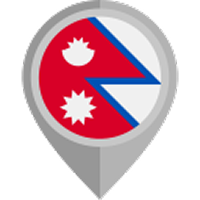Nepal vision | 20/02/2025
The Kanchenjunga Base Camp Trek's difficulty depends on the person asking the question. It is an exhilarating and adventurous journey through the remote and unexplored gems of the eastern region, circling the majestic Kanchenjunga and other notable peaks.
It is considered moderate for beginner trekkers, and they need proper physical and mental fitness to tackle these challenges. At the same time, experienced trekkers may find it more manageable due to their previous experience.
The steep ascents decent, high altitude pass, and rugged mountain terrain are a bit demanding. Likewise, the three-week journeys in such a strenuous landscape and high altitude are another factor that challenges the trekkers.
Despite all the factors influencing the difficulty, one can get rewards that are worth the effort. The cultural charm of the scattered small and large monasteries, cultural artefacts and the friendly local people immersing in their ancient culture and customs. Alongside the majestic charm of Kanchenjunga, Lhotse, Everest, Makalu, Jannu, Rohtang, Ramtang Peak, Taple Sikhar, Nepal Chuli, Kirat Chuli, Kabru
For thrill-seekers and adventurers who are willing to take on the Kanchenjunga base camp trek difficulty, we are here to break down each aspect to help you get the experience of your next adventure.
Kanchenjunga Base Camp Trek Facts
Kanchenjunga Base Camp Trek is an unexplored gem with stunning views of towering peaks, a diverse forest of rhododendrons, a cardamom farm, exotic wildlife and exposure to the remote lifestyle of the ancient local and traditional values.
You start your journey with the 40-minute flight to Bhadrapur and then a short and scenic drive through the countryside, which will reach Taplejung. Now you start on your trek through the picturesque villages of Mitlung, Chirwa, Sekathum, Amjilosa, Gyabla, Ghunsa, and Khambachen, before reaching the North Base Camp at Pangpema and then backtracking to Ghunsa to head toward the South Base Camp via Sele La Pass and Tseram.
The walk will include a mix of dense forest, high-altitude landscapes, and the cultural experience of the Limbu and Sherpa communities. Throughout your trek, you will also have an appealing encounter with the exotic flora and fauna living in the Kanchenujga Conservation Area.
In spite of such marvellous experience comes the different factors influencing the difficulty of the Kanchenjunga Base Camp Trek.
- Walk through the lush green forests, alpine meadows, glacial moraines, and high-altitude terrains with visually stunning and varied experiences.
- Encounter ancient monasteries, spinning prayer wheels, and flapping chorten, which reflect the rich Buddhist culture of the region and add a spiritual touch to your journey.
- The serenity experience of remote villages like Ghunsa, and Khambachen, where traditional lifestyle and pristine nature remain largely untouched by modernity.
- Spot endangered species like the snow leopard, red panda, Himalayan black bear, and musk deer in the Kanchenjunga Conservation Area

Kanchenjunga Base Camp Trek Difficulties and How to Cope with Them
The Kanchenjunga Base Camp Trek is among Nepal’s most demanding trekking experiences. You must have excellent physical fitness, prior high-altitude trekking experience, and intense mental resilience. Let's take a quick look at the trek’s difficulty and key considerations.
Remote Location and Limited Facilities
The remote and rugged location of the Kanchenjunga region has less or even minimal infrastructure, thus making transportation and rescue operations difficult. Many trails pass through isolated areas where roads are scarce, and access to basic facilities is limited. Moreover, in case of emergency, basic medical aid takes hours to reach.
The accommodations in higher elevations are basic; thus, people have to reside in tented camps with limited food options. In addition, communication services are unreliable, as mobile networks and internet connectivity are weak, making it hard to stay in touch with the outside world.
Coping Strategies
- Be Self-Sufficient: Carry essential supplies, including:
- First-aid kit with medications like Paracetamol Diamox for common ailments.
- Water purification tablets or a portable filter.
- High-energy snacks to supplement meals.
- Pre-Book Accommodations: In peak seasons of spiring and autumn, it is better to book in advance as some teahouses fill up quickly.
- Satellite Communication: Carry a satellite phone or buy local SIM for emergency contact
High Elevation and Altitude Sickness
The trails take you above 4000m, where the oxygen level is reduced, making breathing more difficult. Many trekkers experience altitude sickness, which can include headaches, vomiting, dizziness, nausea, and shortness of breath.
Note: The guides from Nepal Vison Trke holding the first aid training suggest carrying Diamox to alleviate the initial condition of altitude sickness.
Further, in more severe cases, altitude sickness can escalate into life-threatening conditions like High Altitude Pulmonary Edema (HAPE) or High Altitude Cerebral Edema (HACE). In this condition, immediate descent and medical attention are required.
Due to their extreme altitudes, some of the significant high-altitude passes along trekking routes, such as the Sele La Pass (4,290 m/14,074 ft), Sinion La Pass (4,660 m/15,288 ft), and Mirgin La Pass (4,480 m/14,698 ft), present exceptionally high risks for AMS.
Coping Strategies
- Acclimatize Properly: Follow a gradual ascent:
- Include rest days (e.g., after gaining 1000m).
- Avoid gaining more than 500 meters (1,640 feet) per day above 3,000 m.
- Follow the "Climb High, Sleep Low" Principle: Trek to higher altitudes during the day but sleep at a lower altitude at night.
- Stay Hydrated: Drink at least 3-4 liters of water daily.
- Eat Carbohydrate-Rich Foods: Helps maintain energy and oxygen levels.
- Descend Immediately if Symptoms Worsen: Never push forward with severe altitude sickness.
Length and Daily Trekking Hours
The trek through the remote landscape is challenging, but the journey of 6-9 hours a day for 20 days is yet another physical challenge. The continuous uphill and downhill movement, combined with carrying a backpack, is another reason for physical fatigue. In addition, the repetitive nature of trekking day after day may result in mental exhaustion, with some trekkers struggling with motivation.
Coping Strategies
- Pre-Trek Training: Build stamina 2–3 months before the trek by starting with an initial walk, staircase taking, and then building up your workout routine, including Cardio exercises (running, cycling, swimming). Strength training (squats, lunges, and core exercises). For an extra challenge, practice hiking with a weighted backpack.
- Use Trekking Poles: Reduces strain on knees and joints.
- Lighten Your Load: Pack only essentials or hire a porter.
- Mental Preparation: Set small daily goals and stay motivated by focusing on the journey rather than the difficulty.
Other Things To Consider For Kanchenjunga Base Camp Trek
The factors of difficulty of the Kanchenjunga Trek are one to look out for. However, there are other factors that trekkers need to understand and prepare for before the trek.
Permits & Costs for the Kanchenjunga Trek
There are a few requirements for entering the restricted Kanchenjunga region. Your group must consist of at least two people, and each trekker needs to have two permits. Additionally, a government-licensed guide is necessary for the trek. If you choose to trek with Nepal Vision Treks, all permit fees are included in your package. The permit process for Kanchenjunga is more complex than for other regions, but rest assured—we will handle all the necessary paperwork and obtain the permits on your behalf.
Here are the costs for the permits:
- Kanchenjunga Conservation Area Project Entry Permit (KCAP): 2000 Nepali rupees per person (no time restrictions).
- Restricted Area Entry Permit (RAP) for Tapethok and Yamphuding: 20 USD per person per week.
These permits are essential to ensure your safe and legal trekking experience in the Kanchenjunga region.
Accommodation & Food Along the Trail
Along the trail of Kanchenjunga Base Camp Trek, the tea houses are scattered, giving the essential service of shelter and food, so there's no need to carry camping gear or cooking supplies. Since the rooms are simple and unheated, we will provide you with a clean -20°C sleeping bag to ensure warmth and comfort. The bathrooms are squat type, and the chance to get a private bathroom is limited, too. If you're at lower elevations, you might be able to purchase a hot shower but expect to pay more than on more frequented routes. If you have any other dietary restrictions, simply let us know, and we will coordinate with the kitchen staff to accommodate your needs.
The meals are healthy and locally soirced food to provide you with the energy required for the trek,
Menus generally offer a mix of local and Western dishes, but we highly recommend opting for local cuisine to ensure the food is fresh and filling. A popular choice is Dal Bhat a mix of of rice, vegetable curry, and lentil soup with unlimited refills. You can also enjoy fried rice, noodles, Mo Mo (local dumplings), Thukpa (Tibetan noodle soup), spring rolls, or even Western options like pasta, pizza, and potatoes.
Packing List for the Kanchenjunga Trek
- Clothing: Layered clothing for cold weather, Waterproof jacket and pants, Insulated jacket, Trekking shirts (long and short-sleeved), Trekking pants, Thermal base layers (top and bottom), Fleece jacket or sweater, Gloves, hat, and scarf, Warm socks (preferably wool), Sun hat or cap
- Footwear: Trekking boots (sturdy, waterproof), Sandals or camp shoes, Warm socks (multiple pairs)
- Sleeping: Sleeping bag (-20°C rating), Sleeping bag liner
- Backpack & Travel Bags: Rucksack (40–60 liters), Duffel bag (for porters)
- Medical Kit & First Aid: AMS medication (Diamox or similar), Pain relief medication, Band-aids and blister plasters, Antiseptic cream, Personal medications, Sunscreen and lip balm (SPF 30+), Hand sanitizer
- Practical Items: Trekking poles (adjustable), Headlamp (with extra batteries), Water bottle or hydration system, Water purification tablets or filter, Camera and spare memory cards, Power bank (solar charger if possible), Travel adapter (if needed), Snacks (energy bars, nuts, etc.)
- Extras & Luxuries: Camera or GoPro, Journal or notebook, Book or e-reader, Lightweight towel, Wet wipes or face wipes, Dry bags for packing clothes
To wrap up, The Kanchenjunga Base Camp Trek is a challenging adventure suited for experienced trekkers. With high-altitude terrain, long trekking hours, and basic facilities, it's essential to be physically prepared and acclimatized. Despite the difficulty, the breathtaking views and cultural experiences make it worthwhile.
For a smooth and safe trek, Nepal Vision Treks takes care of all logistics, permits, and support. Contact us today to start your Kanchenjunga journey
FAQS









